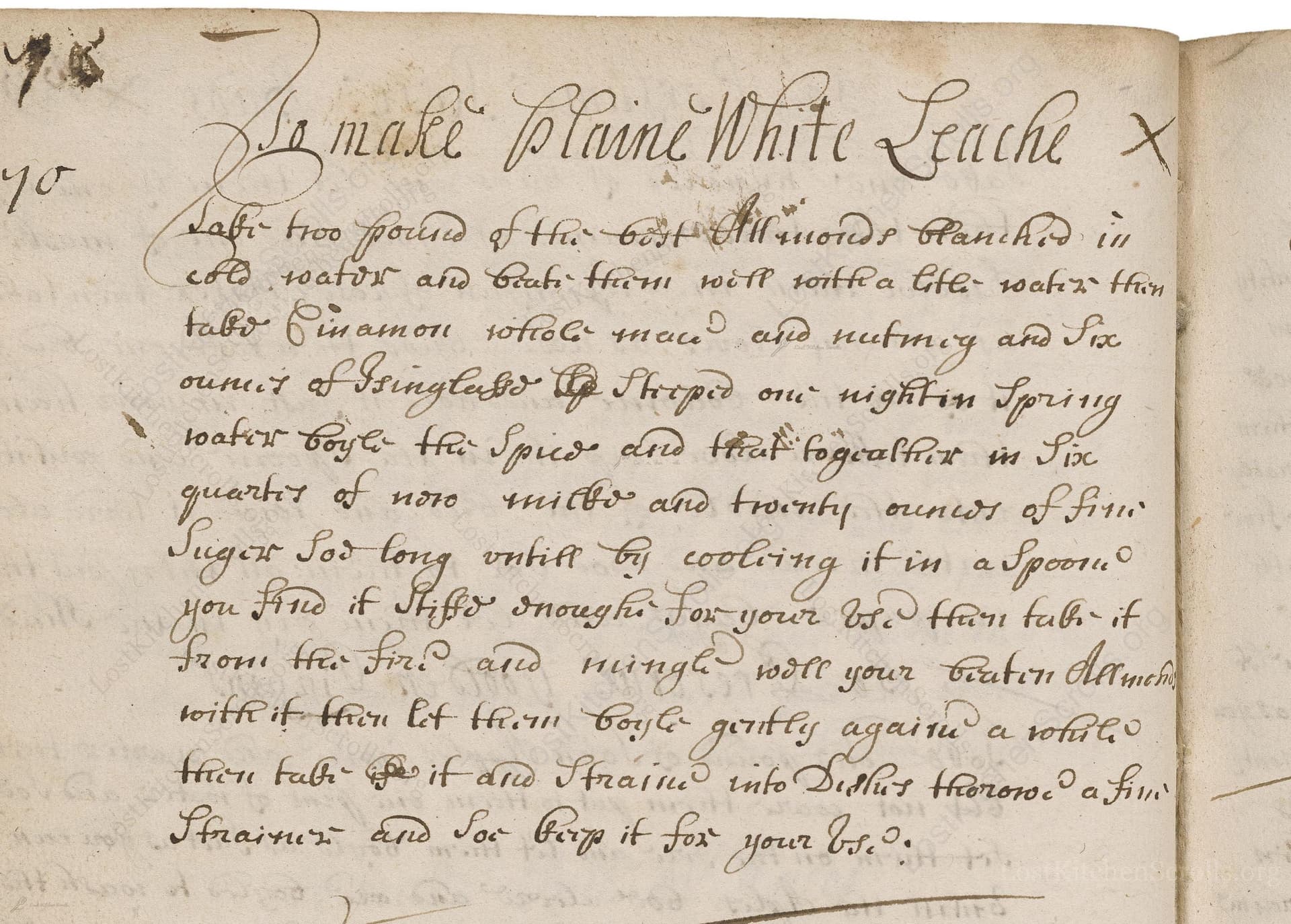To Make Plaine White Leache
From the treasured pages of Cookery book of Ann Goodenough
Written by Ann Goodenough

To Make Plaine White Leache
"Take two pounds of the best Almonds Blanch'd in cold water and beat them very well with a little water then take Cinnamon eight ounces of Isinglasse a quarter of Ginger six scruples one nutmeg and Six dates Strip'd one night in Spring water Boyl these Spices and treat together in Six quarts of new milke and twenty ounces of fine Sugar Soy long untill by cooling it in a spoone you find it stifse enough, for your use, then take it from the fire, and mingle with your beaten Almonds with it then let them Boyle gently againe a while then take it and straine into dishes thereowe, a fine Straind and So keepe it for your use:"
Note on the Original Text
This recipe, like many from the 18th century, is written with assumed knowledge and lacks precise measurements or detailed instructions. Quantities are often given by weight (pounds, ounces, scruples), and the sequence is as much a prompt for the experienced cook as it is a guideline. Spellings are archaic ('milke', 'Boyl', 'stiffe') and phases like 'take it from the fire' or 'boyle gently againe' rely on the reader's intuition. Modern cooks benefit from metric precision, but the heart of the recipe—the delicate balance of sweetness, spice, and set almond cream—remains unchanged.

Title
Cookery book of Ann Goodenough (1738)
You can also click the book image above to peruse the original tome
Writer
Ann Goodenough
Era
1738
Publisher
Unknown
Background
A delightful journey into the kitchens of early 18th-century England, this collection captures the flair and flavors of its time with recipes crafted by the inventive Ann Goodenough. Expect a charming medley of hearty roasts, comforting pies, and time-honored confections, perfect for those wishing to dine as they did in Georgian days.
Kindly made available by
Folger Shakespeare Library
This recipe for 'Plaine White Leache' (plain white leach) originates from Ann Goodenough, a cook active around 1700–1775 in Britain. Leach was a popular sweet dish at early modern European banquets, prized for its delicate almond flavor and elegant, sliceable consistency—a testament to both skill and luxury at the time. Dishes like this were enjoyed at elite tables and reflected the wealth and sophistication of their households. The use of imported spices, sugar, and isinglass reveals the global connections of 18th-century kitchens and the social aspiration behind such recipes.

Traditionally, cooks would use a large brass or copper cauldron for boiling the milk and infusing the spices. Almonds were ground by hand in a mortar and pestle. After the final mixing, the hot mixture would be strained through a fine cloth (often linen or muslin) into wooden or ceramic molds or dishes, and left to cool in a cool part of the kitchen or a larder. Spoons for stirring and testing texture were typically made of wood or horn.
Prep Time
40 mins
Cook Time
45 mins
Servings
12
We've done our best to adapt this historical recipe for modern kitchens, but some details may still need refinement. We warmly welcome feedback from fellow cooks and culinary historians — your insights support the entire community!
Ingredients
- 2 lbs blanched almonds
- A little cold water (for soaking and blending)
- 0.7 oz cinnamon sticks
- 8 oz isinglass (or substitute with 3.5 oz good quality gelatin)
- 0.04 oz ground ginger (approx. 6 scruples)
- 1 whole nutmeg, grated
- 6 pitted dates (about 1.25 oz), soaked overnight in spring water
- 1 1/2 gallons fresh whole milk
- 1 1/4 lbs fine sugar
Instructions
- Begin by blanching 2 pounds of the best almonds in cold water, then pound them to a smooth paste with a little additional water.
- Next, take 0.7 ounces of cinnamon sticks, 8 ounces (or substitute with 3.5 ounces of high-quality gelatin), 0.04 ounces of ground ginger, 1 whole nutmeg grated, and 6 pitted dates (about 1.25 ounces), soaked overnight in spring water.
- In a large pot, boil these spices and dates together with 1 1/2 gallons of fresh whole milk and 1 1/4 pounds of fine sugar.
- Simmer gently, occasionaly testing by cooling a spoonful—when it thickens as it cools, it is ready.
- Remove from heat, stir in the almond paste thouroughly, and return to a gentle simmer for a short while.
- Finally, strain the mixture through a fine sieve or cheesecloth into serving dishes or molds, then chill until set.
Estimated Calories
400 per serving
Cooking Estimates
Preparing the dish takes about 40 minutes, including soaking, blanching, and blending the almonds, and prepping other ingredients. Cooking takes about 45 minutes as you slowly simmer and combine everything. Each serving is around 400 calories, and the recipe makes 12 servings.
As noted above, we have made our best effort to translate and adapt this historical recipe for modern kitchens, taking into account ingredients nowadays, cooking techniques, measurements, and so on. However, historical recipes often contain assumptions that require interpretation.
We'd love for anyone to help improve these adaptations. Community contributions are highly welcome. If you have suggestions, corrections, or cooking tips based on your experience with this recipe, please share them below.
Join the Discussion
Rate This Recipe
Dietary Preference
Culinary Technique

Den Bockfisch In Einer Fleisch Suppen Zu Kochen
This recipe hails from a German manuscript cookbook compiled in 1696, a time whe...

Die Grieß Nudlen Zumachen
This recipe comes from a rather mysterious manuscript cookbook, penned anonymous...

Ein Boudain
This recipe comes from an anonymous German-language manuscript cookbook from 169...

Ein Gesaltzen Citroni
This recipe, dating from 1696, comes from an extensive anonymous German cookbook...
Browse our complete collection of time-honored recipes



